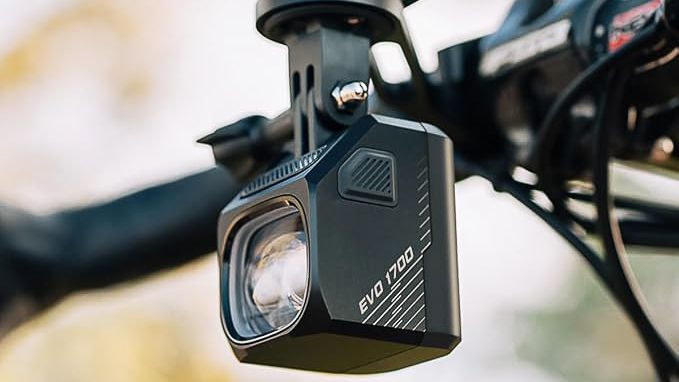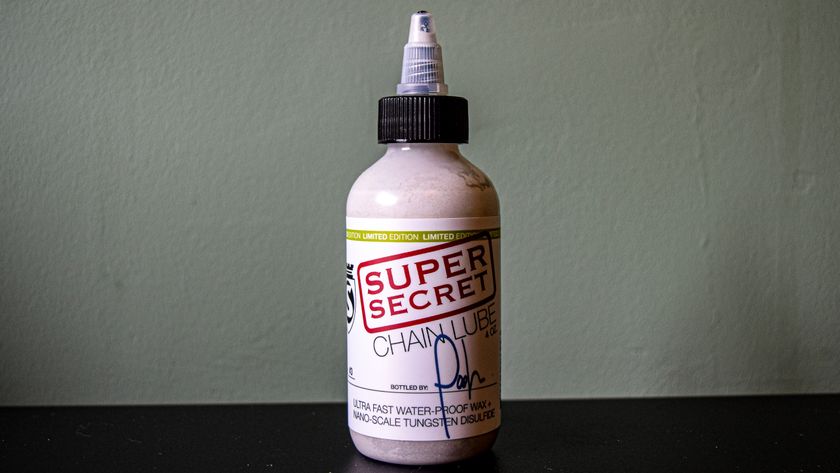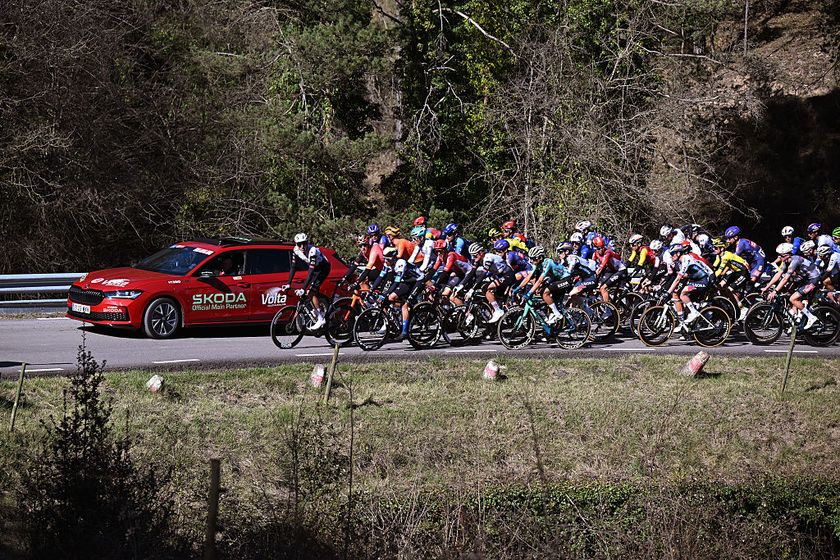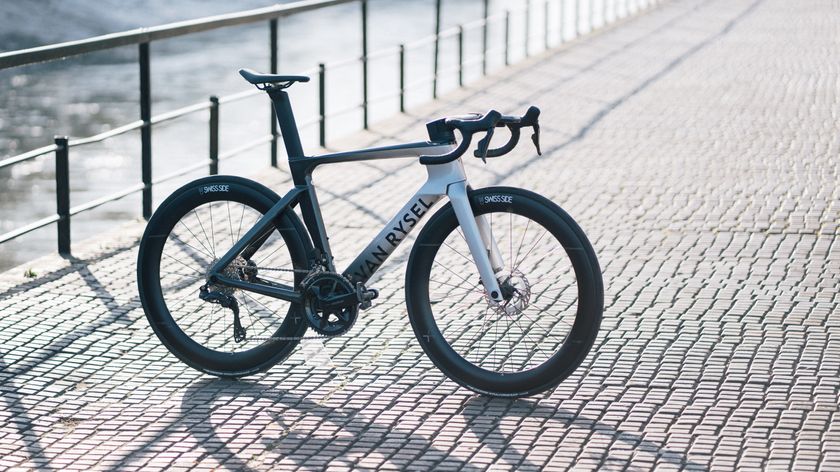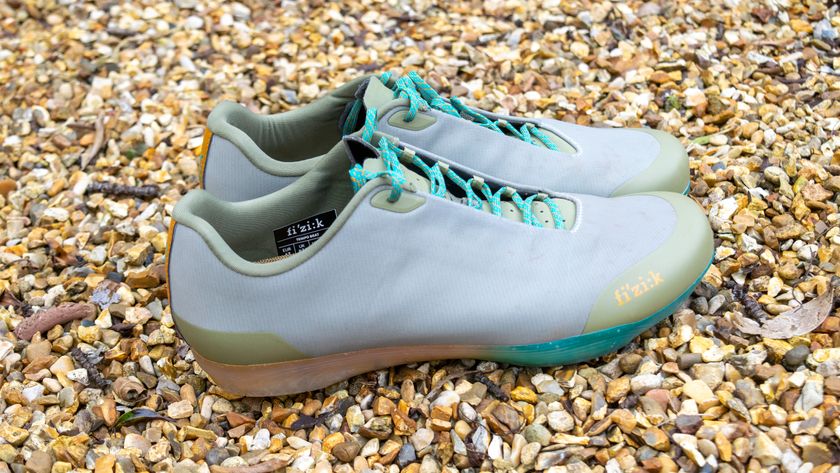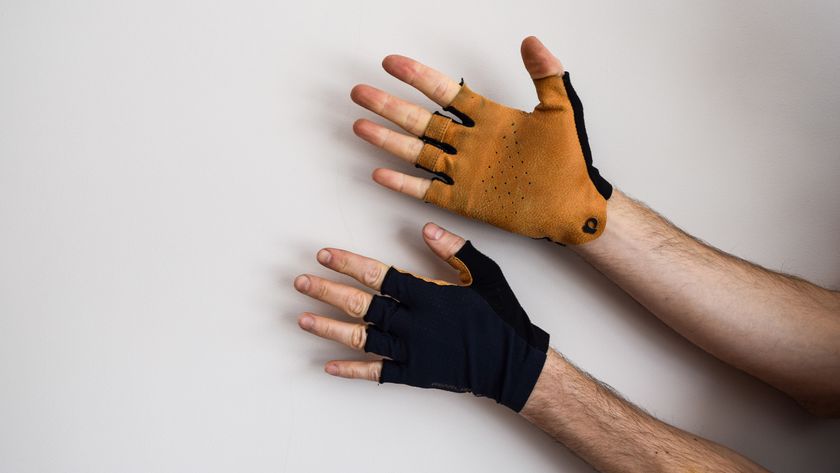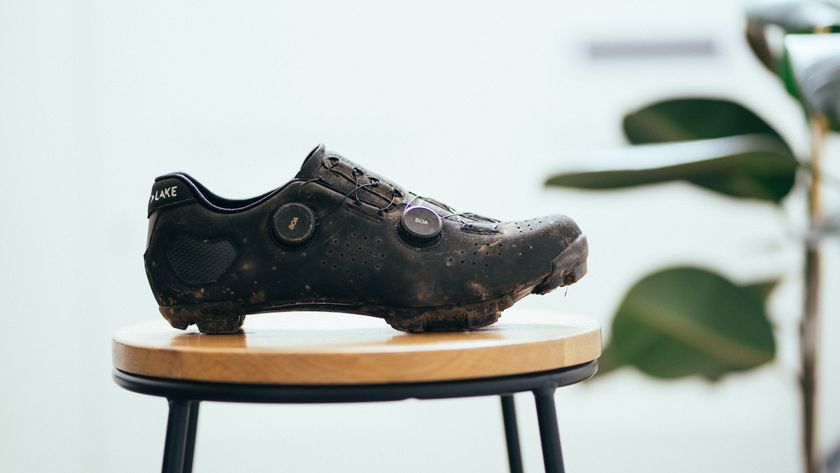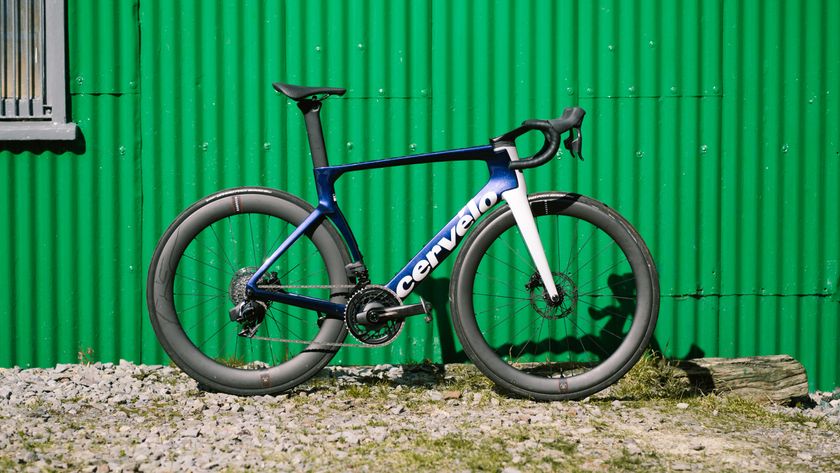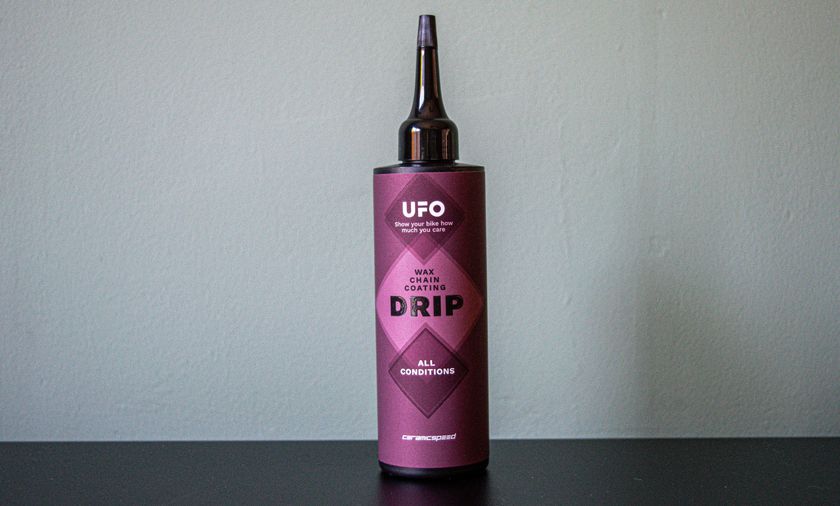You can trust Cyclingnews




























This article originally published on BikeRadar
Specialized takes a unique perspective on its CruX Pro Race Red Disc cyclo-cross bike. Whereas most high-end cyclo-cross bikes include wheels for either everyday training or racing, Specialized includes both a set of alloy clinchers and a pair of carbon tubulars, which is doubly convenient for riders making the jump to disc brakes. Couple that with a fantastic carbon fiber chassis and a smart race-ready component pick and you're ready to hit the barriers.
Ride and handling: brutally efficient with tack-sharp handling
The CruX Pro RaceRed Disc certainly lives up to its name, with fantastic pedaling efficiency and brilliant front-end stiffness. While some other carbon 'crossers adhere to the church of 'flex is good', the CruX is a match made in heaven for efficiency-minded riders who tend to rely on explosive bursts of speed in a race. It's an absolute rocket ship under power, with an ultra-stout backbone that doesn't yield even a little when you're mashing on the pedals.
That stiffness isn't limited to the rear end, either, as the front end of the CruX feels remarkably solid during out-of-saddle sprints and short climbs. Handling is fantastically precise too, with laser-sharp reflexes that combine with a relatively short trail dimension for a truly point-and-shoot personality.
That's not to say that the CruX is twitchy or unstable though. Specialized builds the frame with unquestionably new-school geometry that includes a very generous 71mm of bottom bracket drop for a noticeably low center of gravity. Despite the darty front-end geometry, the bike is still confidently stable when drifting through slippery turns, meaning the CruX is quick to change direction but more resistant to laying down.
One course we raced on featured a small downhill log immediately followed by a loose and dusty right-left-right chicane. We had no problems tackling the step-down at speed, flicking to the right, and then snapping the rear end around for the following corner.
Comfort-wise, the CruX is more of a mixed bag. At the bike's debut, Specialized touted the new carbon CruX as a sort of "Tarmac for the dirt" and based on the performance traits above, the company has largely nailed that goal. However, we could have done with a little more cush from the rear end. The CruX very capably damps vibration, like the Tarmac does, but also like its road-going cousin, the rear end doesn't actually flex that much so bigger impacts can unsettle things, particularly in bumpy corners where a smoother chassis such as Cannondale's SuperX Hi-Mod Disc is a little more likely to carve through.
Fit and positioning seemed spot-on with the medium-length (125mm on our 52cm sample) head tube providing plenty of latitude for either a super aggressive handlebar or a slightly more leisurely setup. The top tube is only modestly sloping, providing extra clearance but leaving enough room for easy shouldering on long run-ups – plus the underside is very broad and flat to help lessen the pain.
We didn't have the opportunity to thrash the CruX through heavy mud but we have little reason to think that it wouldn’t do well. There's gobs of room in between the disc-specific seat stays for mud to pass through and plenty down at the chain stays too – plus there's no horizontal shelf behind the bottom bracket shell on which debris can accumulate.
Though the fork doesn't have canti bosses on it, it's still clearly a derivative of the standard CruX model so the blades aren't as wide as they perhaps could be. That being said, the crown is nevertheless widely set with lots of real estate all around the tire, even when running oversized 37mm-wide rubber, so we've little reason to expect that things would jam up prematurely.
Frame: might as well call it a Tarmac
That Tarmac-like characteristic easily applies to the CruX's frame shape and in fact, you'd be forgiven for mistaking one for the other as nearly every key design element is carried over on its modular monocoque carbon fiber frame.
The simply enormous down tube is quite possibly the biggest we've seen on a 'cross frame and the top tube is broad and flat. Both seemingly wrap around the tapered hourglass-profile, 1.125 to 1.375in head tube – a trick Specialized claims provides extra torsional rigidity.
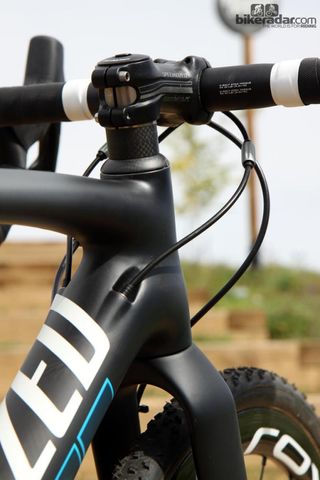
The top tube and down tube effectively 'wrap around' the tapered head tube to boost front-end stiffness
Again like the Tarmac, the tapered seat tube starts out round up top before morphing into a more rectangular profile down at the pseudo-PF30 bottom bracket shell. Connected to that are huge chain stays terminating in carbon fiber dropouts, all joined to relatively slender disc-specific seat stays. Sounds familiar, right?
For sure there are several 'cross specific tweaks, including a small indentation on the underside of the down tube to make it easier to grab and requisite geometry adjustments to accommodate the wider tires. Otherwise, though, you could easily toss some road tires on here and happily use the CruX as your everyday pavement rig as long as you're okay with the slightly lazier handling as compared to the even-edgier Tarmac.
Cable routing is internal throughout including for the rear hydraulic disc hose. Specialized thankfully incorporates SRAM's handy Connectamajig for easier servicing if needed (at least for a few times) although the little rubber grommets used to secure the line in the frame are disappointingly chintzy for a US$6,000-plus bike. One of ours was constantly coming loose.
Derailleur cable paths mimic those of the Tarmac, so while they're not fully guided, they're relatively straightforward to string. Should you decide to switch later, the frame is electronic transmission compatible too.
Actual frame weight is 1,194g for our 52cm sample, complete with derailleur hanger, seatpost collar, aluminum water bottle bolts, and cable routing hardware. The matching fork adds 481g (without steerer plug). Neither figure is particular ultralight by high-end carbon fiber standards – though in fairness, Specialized's own flagship S-Works CruX is supposedly about 150g lighter – but it's still acceptable given the remarkable stiffness.
Equipment: smart race-ready spec
Rather than go all-out on top-end gear, Specialized has instead outfitted the CruX Pro Race Red Disc with a smart blend that's well suited to the rigors of competition. For example, flagship SRAM Red 22 shifter/brake levers and hydraulic disc brakes are matched to a Force 22 cassette and derailleurs. For sure, there's a slight weight penalty but it's essentially counteracted by the inclusion of Specialized's own FACT Pro carbon crankset.
Regardless, shift performance is crisp and precise with snappy gear changes and as always, lots of audible and tactile feedback from the SRAM levers. Speaking of which, the bulbous hood shape certainly won't appeal to everyone but from a functional standpoint, the bigger upper protrusions do a great job of helping to keep your hands in place on rough courses without requiring any sort of death grip.
It should also come as no surprise that brake performance is outstanding overall with ample (but not excessive) power from the 160/140mm front/rear rotor pairing and fantastic control. Especially when compared to braking on a carbon rim, we found the speed control on the Red discs to be far more consistent with better initial bite and a smooth progression of power throughout the lever stroke.
The lack of any sort of proper pad contact adjustment is a major disappointment, however. Reach can be customized but you'd better like how far the levers travel before the pads engage because there's nothing you can do about it.
Specialized's product managers have made similarly smart decisions in terms of cockpit components, although some might accuse the Big S of going a little conservative here. The bend on the CX Expert bar is plenty comfortable and its alloy construction is amply stiff. Similarly, the matching Pro-Set angle-adjustable stem is stout and sturdy, and the pair noticeably adds to the CruX's enviable front-end confidence.
That being said, the bar-and-stem combo is also quite heavy at about 500g. Swapping to a carbon bar and non-adjustable stem would lop off about 200g – nearly 0.5lb.
We have few complaints when it comes to the seating arrangements though. The Phenom Comp saddle is fantastically comfortable (though perhaps a bit firm for sloppy remounts) and the matching Specialized Pave SL seatpost adds a bit of much needed flex to the rear end.
Finally, we come to the rolling stock. We applaud Specialized for the concept of including two sets of wheels with the CruX Pro Race Red Disc but the end result leaves a little to be desired.
The DT Swiss Axis 2.0 Disc clinchers are expectedly heavy at 2,100g per pair and bring the total bike weight to a somewhat hefty 8.60kg (18.96lb, 52cm, without pedals). As they're only really intended for training though, they get the job done. By that measure, the matching Specialized Tracer Sport tires feature a good do-it-all tread design that works well enough in everything but sloppy mud.
Even so, we would have liked to see wider rims (internal width is just 17mm) to better suit fatter cyclo-cross rubber. Likewise, tubeless compatibility would have been great to prevent flats – less fixing equals more training, after all, and a tubeless setup's lower operating pressures would be a closer approximation to tubulars on race day. We're not encouraged by the long-term durability prospects, either, as our front hub started to feel rough nearly straight away.
Swapping in the included Roval Rapide CL 40 carbon tubulars brings the bike weight down to a much more competitive 7.79kg (17.17lb). Moreover, the included Specialized Terra tubulars (which don't come pre-glued, by the way) are far more versatile than their mud billing would otherwise suggest and their reasonably supple nylon casings are certainly tougher than a more ground-hugging handmade cotton tire – an important trait for a rider that might not have multiple sets of wheels at their disposal.
If you really want to nitpick, it's worth mentioning that Specialized builds the Roval Rapide CL tubulars with DT Swiss Competition spokes instead of the lighter DT Revolution ones used on the otherwise functionally identical CLX, which tacks on about 100g. But given the cost of good disc-compatible carbon tubulars – Zipp's 303 Firecrest Disc are US$2,500/£2,300, for example – it seems like more than a fair compromise if that what it takes to get them included in the CruX's purchase price.
We can't forgive so easily the disparate rotor spacing, though. Specialized intends for the two wheelsets to be quickly swapped but there's no way to do so properly without realigning the disc calipers each time. Unfortunately, you can't correct the problem with Syntace's handy disc shims, either, plus Specialized only includes one cassette to share between the two rear wheels.
Small issues aside, what you're left with is a great race ready package that needs virtually nothing before hitting the barriers. Slap on your favorite pedals, a number, and some embro and you'll not only be ready to go but there's little reason left for major upgrades later on too.
Price: US$6300
Pros: Fantastically stiff and responsive chassis, quick handling, smart component spec, two sets of wheels included
Cons: Training clinchers are so-so, heavy cockpit, somewhat stiff ride, frame and fork aren't all that light
BikeRadar verdict: 4 stars
More information: www.specialized.com
Complete bicycle specifications
Frame: Specialized CruX Pro Race Red Disc
Available sizes: 46cm, 49cm, 52cm (tested), 54cm, 56cm, 58cm, 61cm
Available colours: Satin Carbon/Charcoal/Multi Keyline
Fork: Specialized FACT Carbon, disc-specific
Headset: integrated, 1 1/8-to-1 3/8in tapered
Stem: Specialized Pro-Set
Handlebars: Specialized CX Comp Shallow Bend
Tape/grips: Specialized S-Wrap HD
Front brake: SRAM Red hydraulic disc
Rear brake: SRAM Red hydraulic disc
Brake levers: SRAM Red 22 Hydro Shifter
Front derailleur: SRAM Force 22
Rear derailleur: SRAM Force 22
Shift levers: SRAM Red 22 Hydro Shifter
Cassette: SRAM PG-1170, 11-28T
Chain: SRAM PC-1170
Crankset: Specialized Pro FACT Carbon
Bottom bracket: Specialized
Pedals: n/a
Wheelset: Roval Rapide CL 40 Disc Tubular
Tires: Specialized Terra tubulars
Wheelset: DT Swiss Axis 2.0 Disc clinchers
Tires: Specialized Tracer Sport clinchers
Saddle: Specialized Phenom Comp
Seatpost: Specialized Pave Pro SL
Weight: 7.79kg (17.17lb) with tubulars
Weight: 8.60kg (18.96lb) with clinchers
